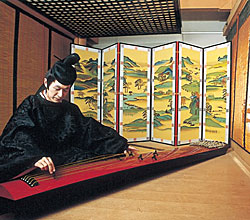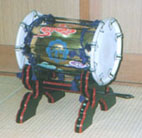Gagaku instruments
(all sound clips on this page are .ram and require RealPlayer)
Wind instruments
笙(しょう)Shō |
||
 |
17 bamboo pipes. |
Links |
篳篥(ひちりき) Hichiriki |
||
 |
18 cm bamboo flute with 7 holes in the front and 2 in the back. The reed is held in the mouth. |
Links |
竜笛(りゅうてき) Ryūteki |
||
 |
40 cm bamboo flute with 7 holes in the front and one hole to blow into. |
|
String instruments
Four stringed instruments (Heian period) |
||
 |
||
琵琶(びわ) Biwa |
||
  |
Biwa sound clip | |
琴(きん) Kin |
||
  |
Seven strings. Imported in the Nara period, fell out of use during the mid-Heian period. We revigorated in the Edo period but is not widely used today. Kin sound clip |
|
和琴(わごん) Wagon |
||
  |
Six strings. |
|
箏(そう) Sō |
||
 |
Arriving from China in the 7th c. At that time there were 12 and 13 stringed instruments in China; it was the 13-stringed instrument that was imported. Made from paulownia wood. |
Links |
Percussion instruments
太鼓・大鼓(たいこ) Taiko |
||
 |
A large drum with a painted surface. Originates in China. Struck with a soft mallet. | |
羯鼓・鞨鼓(かっこ) Kakko |
||
 |
A double-headed, small drum. The drum surface is animal skin. The cords running parallel to the drum can be manipulated to alter the tension of the drums surface, and so the sound of it. Struck with the hands. | |
鉦鼓(しょうこ) Shōko |
||
 |
A medium-sized, bronze gong. | |
笏拍子(しゃくびょうし) Shakubyōshi |
||
 |
Percussion mallets about 36 cm long and 1 cm thick, made from boxwood, cherry wood, plum wood or other woods. Held in the two hands. | |